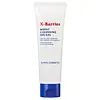What's inside
What's inside
 Key Ingredients
Key Ingredients

 Benefits
Benefits

 Ingredients Side-by-side
Ingredients Side-by-side

Cetyl Ethylhexanoate
EmollientTriethylhexanoin
MaskingGlycerin
HumectantButylene Glycol
HumectantWater
Skin ConditioningPEG-20 Glyceryl Triisostearate
EmollientGlycosyl Trehalose
Emulsion StabilisingAphanothece Sacrum Exopolysaccharides
AbsorbentTocopherol
AntioxidantDisodium EDTA
Triethanolamine
BufferingAcrylates/C10-30 Alkyl Acrylate Crosspolymer
Emulsion StabilisingGlycerylamidoethyl Methacrylate/Stearyl Methacrylate Copolymer
HumectantPotassium Cocoyl Glycinate
Sodium Methyl Cocoyl Taurate
CleansingCholesterol
EmollientSqualane
EmollientSodium Methyl Stearoyl Taurate
CleansingTriceteareth-4 Phosphate
EmulsifyingPhytosteryl/Octyldodecyl Lauroyl Glutamate
Skin ConditioningHydrogenated Starch Hydrolysate
HumectantCetyl Ethylhexanoate, Triethylhexanoin, Glycerin, Butylene Glycol, Water, PEG-20 Glyceryl Triisostearate, Glycosyl Trehalose, Aphanothece Sacrum Exopolysaccharides, Tocopherol, Disodium EDTA, Triethanolamine, Acrylates/C10-30 Alkyl Acrylate Crosspolymer, Glycerylamidoethyl Methacrylate/Stearyl Methacrylate Copolymer, Potassium Cocoyl Glycinate, Sodium Methyl Cocoyl Taurate, Cholesterol, Squalane, Sodium Methyl Stearoyl Taurate, Triceteareth-4 Phosphate, Phytosteryl/Octyldodecyl Lauroyl Glutamate, Hydrogenated Starch Hydrolysate
 Reviews
Reviews

Ingredients Explained
These ingredients are found in both products.
Ingredients higher up in an ingredient list are typically present in a larger amount.
Cetyl Ethylhexanoate is an emollient ester. It comes from cetearyl alcohol and 2-ethylhexanoic acid.
Cetyl Ethylhexanoate is an emollient that adds a velvety feel to skin without being greasy or oily. Emollients help trap moisture into your skin, keeping your skin soft and hydrated.
Glycerin is already naturally found in your skin. It helps moisturize and protect your skin.
A study from 2016 found glycerin to be more effective as a humectant than AHAs and hyaluronic acid.
As a humectant, it helps the skin stay hydrated by pulling moisture to your skin. The low molecular weight of glycerin allows it to pull moisture into the deeper layers of your skin.
Hydrated skin improves your skin barrier; Your skin barrier helps protect against irritants and bacteria.
Glycerin has also been found to have antimicrobial and antiviral properties. Due to these properties, glycerin is often used in wound and burn treatments.
In cosmetics, glycerin is usually derived from plants such as soybean or palm. However, it can also be sourced from animals, such as tallow or animal fat.
This ingredient is organic, colorless, odorless, and non-toxic.
Glycerin is the name for this ingredient in American English. British English uses Glycerol/Glycerine.
Learn more about GlycerinPeg-20 Glyceryl Triisostearate comes from Isostearic Acid and glycerin.
It is an emollient, emulsifier, and gentle cleanser. As an emollient, it helps trap moisture to keep skin soft and hydrated. Emulsifiers help prevent ingredients from separating.
This ingredient is common in oil-based products. This is because it helps oil-ingredients be easily washed away without leaving a residue.
Peg-20 Glyceryl Triisostearate may not be fungal-acne safe.
Learn more about PEG-20 Glyceryl TriisostearateTriethylhexanoin is created from glycerin and 2-ethylhexanoic acid. It is a solvent and emollient.
As a solvent, Triethylhexanoin helps dissolve ingredients to stable bases or help evenly distribute ingredients throughout the product.
It is also an emollient and helps condition the skin.
Learn more about TriethylhexanoinWater. It's the most common cosmetic ingredient of all. You'll usually see it at the top of ingredient lists, meaning that it makes up the largest part of the product.
So why is it so popular? Water most often acts as a solvent - this means that it helps dissolve other ingredients into the formulation.
You'll also recognize water as that liquid we all need to stay alive. If you see this, drink a glass of water. Stay hydrated!
Learn more about Water